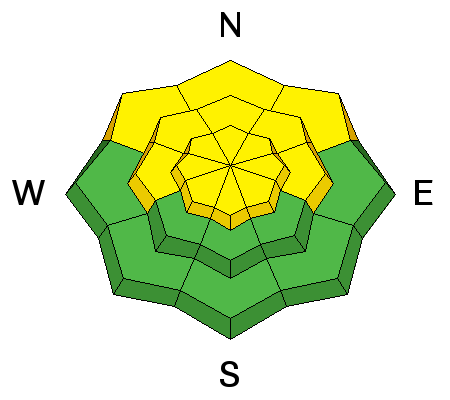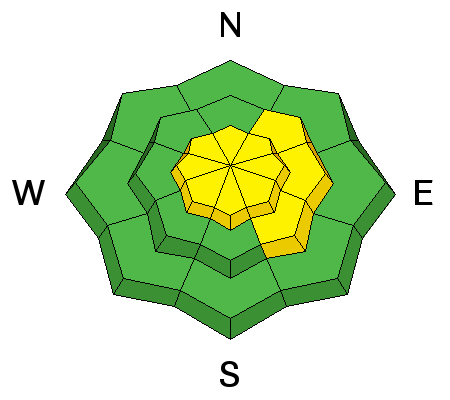| Please join us at the 23rd annual Black Diamond Fall Fundraiser Party Thursday Sept 15. Tickets are on sale now here, at the Black Diamond store & at REI. Special bonus raffle for online ticket purchasers! |  |

| Please join us at the 23rd annual Black Diamond Fall Fundraiser Party Thursday Sept 15. Tickets are on sale now here, at the Black Diamond store & at REI. Special bonus raffle for online ticket purchasers! |  |
| Advisory: Logan Area Mountains | Issued by Paige Pagnucco for Monday - February 8, 2016 - 6:20am |
|---|
 |
current conditions The temperature is 24 degrees this morning at the 8400' Tony Grove Snotel, and there's 75 inches of total snow, containing 107% of average water content for the date. The 9700' CSI Logan Peak weather station reports 22 degrees and a steady 18 mph wind from the northwest. You'll still find soft settled powder in protected areas and lower angle slopes are riding fast. The sun has affected south facing slopes. |
 |
recent activity
|
| type | aspect/elevation | characteristics |
|---|


|


|

LIKELIHOOD
 LIKELY
UNLIKELY
SIZE
 LARGE
SMALL
TREND
 INCREASING DANGER
SAME
DECREASING DANGER
|
|
description
A lingering possibility of triggering a dangerous deep slab avalanche exists in outlying terrain and on isolated slopes with shallow snow cover. The slopes we are concerned with have poor snow structure. Weak sugary or faceted snow near the ground overloaded by a slab layer of harder snow creates a potentially unstable situation. Beware areas that avalanched earlier in the winter, since weak snow remained in the bed surfaces and the areas remained shallow. Weak snow structure exists mainly in areas where the total snow is 3' deep or less. Deep avalanches are most likely in shallow rocky upper elevation terrain, but the shallow snow is still also weak in many areas at lower and mid elevations. ____________________________________________________________________________________________________________________ Here's a photo of some well-developed facets that make ascending |
| type | aspect/elevation | characteristics |
|---|


|


|

LIKELIHOOD
 LIKELY
UNLIKELY
SIZE
 LARGE
SMALL
TREND
 INCREASING DANGER
SAME
DECREASING DANGER
|
|
description
Northwest winds over the past few days may have drifted snow in exposed terrain, and it is possible to trigger wind slab avalanches on some steep drifted slopes at upper elevations.
|
| type | aspect/elevation | characteristics |
|---|


|


|

LIKELIHOOD
 LIKELY
UNLIKELY
SIZE
 LARGE
SMALL
TREND
 INCREASING DANGER
SAME
DECREASING DANGER
|
|
description
As the snow is warmed by direct sun or today, it'll become moist and may be prone to sluffing on steep slopes. Natural loose wet avalanches may become likely if temperatures rise rapidly, and avalanches might be initiated by snow falling off rocks or trees onto steep slopes below. Roller balls or shallow sluffs indicate the potential and increasing danger of wet avalanches. Loose wet sluffs could gouge down and include significant snow in descent. If the snow you're in starts to become sticky and moist you should avoid steep slopes and head to somewhere less steep or more shady. |
 |
weather Expect a warming trend this week and increasingly fair weather in the mountains as a strong high pressure system dominates the zone. It'll be sunny in the mountains today, with a high temperature at 8500' of around 40 degrees and 15 to 20 mph northwesterly winds on the ridges. It'll be mostly sunny tomorrow, with a high temperature around 44 degrees. Looks like the weather will be nice, sunny, and mild in the mountains while the dreaded inversion builds in the valleys. |
| general announcements Please submit snow and avalanche observations from your ventures in the backcountry HERE. You can call us at 801-524-5304 or email HERE, or include #utavy in your Instagram or Tweet us @UAClogan. To report avalanche activity in the Logan Area or to contact the local avalanche forecaster call me, Toby, at I'll update this advisory throughout the season on Monday, Wednesday, Friday, and Saturday mornings by about 7:30 This advisory is produced by the U.S.D.A. Forest Service, which is solely responsible for its content. It describes only general avalanche conditions and local variations always exist. |
Advisory Hotline: (888) 999-4019 | Contact Information